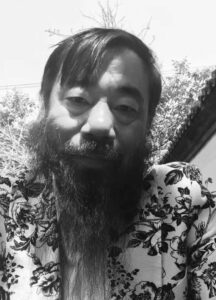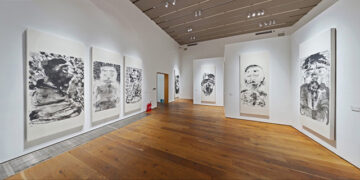李津(1958年生于中国天津)以描绘当代生活中的食、色主题而广为人知。他用色明丽丰富,用笔细腻滋润。画中自画像似的人物被美女、美食环绕,浸淫于世俗的欲望与享乐之中。然而,画中人物木讷的神情却流露出与场景的疏离与自娱自乐的尴尬,似乎狂欢也无法掩饰个人精神中的某种孤独与伤感,也许这只是一场虚幻的梦或回忆。
李津在艺术中一直关注人的精神世界。他早年喜欢梵高和高更,1984年又只身去西藏寻找最原始与自然的生活方式。在西藏观看天葬的经历更使他终生难忘,深深感受到了肉体存在的局限性。他被西藏的宗教以及历史文化氛围所吸引,以至在离开后又两次重返西藏,但他也切身体会到了当地的文化差异,自己终究不会融入其中。
1993年离开西藏时,李津已在绘画中显露出对当代生活的关注。他先去了南京,与新文人画家朱新健的偶识对他影响很大。后来李津在北京胡同生活,创作了一批有老北京风味的作品,饮食、男女逐渐成为他作品经常表达的主题。这种对自己生活与内心的真切描绘,体现出他艺术的“鲜活”气息。后来随李津艺术影响力的提升,他的画面也变得更加热闹,而且会在画中描绘他在国外的生活经历。
2015年李津举办了回顾展《无名者的生活——李津三十年》,对自己之前的艺术做了阶段性总结。同时,他开始了新系列的黑白水墨创作,以更直抒胸臆的大写意风格作画,将多年对色彩细腻精心的渲染,升华和回归为“墨分五色”的精妙。如同他早年去西藏一般,李津似乎又一次从俗世中抽离,去寻求一种自在与随心所欲的创作状态。
李津,1983年毕业于天津美术学院国画系,现任天津美术学院中国画系副教授。2013年获得“AAC艺术中国”(2012)年度水墨艺术家奖。2014年被权威艺术杂志《艺术财经》艺术权力榜评选为2013年度艺术家。曾在国内及美国、澳大利亚、德国等地举办个人画展。作品被中国美术馆、波士顿美术馆、西雅图美术馆、香港艺术馆等机构收藏。
Li Jin (b. 1958 in Tianjin, China) is best known for his lush and colorful depictions of sensory pleasures in contemporary China. In his banquet scenes and anecdotal vignettes, voluptuous men and women are surrounded with food in various states of undress and sexual intimacy, but appear awkwardly out of place or spiritually vacant. Often portraits of the artist himself, the figures suggest both playful self-amusement and reflective distance. Indeed, even at their most extravagant, Li Jin’s pleasures scenes are tinged with the melancholy of solitude and the unreality of a dream or a memory.
In truth, Li Jin’s art has always had a spiritual undertone, perhaps even a spiritual purpose. In 1984, inspired by the examples of van Gogh and Gauguin, he went to Tibet in search for an authentic life and primal connection to nature. There, particularly, after witnessing a sky burial, he began to reflect on the limits of corporeal existence. Drawn to the religiosity and the sense of time and history in Tibetan culture, he would sojourn twice again in the region, but would gradually come to recognize its essential alienness.
Upon leaving Tibet in 1993, he set out to embrace the shifting realities of contemporary China under liberalization. Influenced by his encounter with the New Literati painter Zhu Xinjian in Nanjing, and inspired by his new life in a Beijing hutong, he developed an aesthetics of xianhuo, or “aliveness.” His paintings came to represent food, sex, and other aspects of quotidian life with honesty and enthusiasm, and in a manner strongly evoking first-hand experience. As he gained in reputation and exposure, his paintings also changed, becoming increasingly boisterous and incorporating experiences of his travels abroad.
The major 2015 retrospective exhibition The Sensory Life of the Mass: 30 Years of Li Jin concluded a phase of his career. Li Jin has now turned his focus towards painting in monochrome, translating his well-honed sensitivity towards color washes into a masterful control of tonality–what is traditionally called the “five colors of ink.” He paints in a looser, more gestural and expressive daxieyi style, exploiting the accidental effects of the medium. As if again retreating from the mundane world as he did decades ago in Tibet, Li Jin now seeks to return to a state of freedom and unencumbered creativity.
Li Jin graduated in 1983 from the Chinese Painting Department of the Tianjin Academy of Fine Arts, where he currently serves as Associate Professor. He was awarded Annual Ink Artist at the 2012 Award of Art China. In 2014, he was selected Artist of the Year by the authoritative publication L’OFFICIEL Art. Li Jin has mounted solo exhibitions in China and in Australia, Germany, and the United States, among other countries. His works are in the collections of major institutions such as the National Art Museum of China; Museum of Fine Arts, Boston; Seattle Art Museum; and Hong Kong Museum of Art.


